How to Run MacOS Sierra in a Virtual Machine for Free, the Easy Way
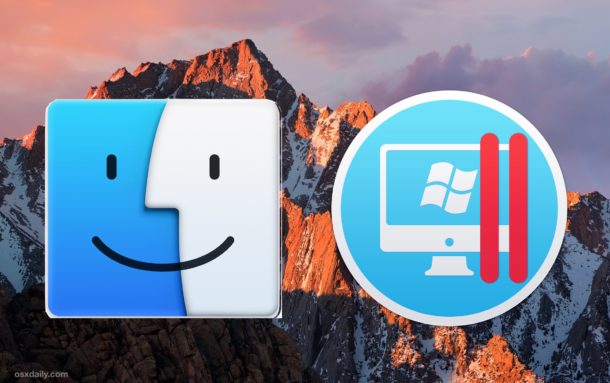
Advanced Mac users may find it useful to run macOS or Mac OS X in a virtual machine atop their existing Mac operating system. Creating a virtual machine for Mac OS is now easier than ever before, and we’ll show you how to set up easy Mac virtual machines on a Mac.
For some quick background, virtualization allows you to run another operating system in a confined virtual machine atop an existing operating system through an application layer. This means there is no disk partitioning involved, the virtualized operating system runs just like any other application on your computer. We have covered this broad topic many times before for purposes like running Windows 10 on a Mac with a VM, to running Ubuntu Linux in VirtualBox, to Snow Leopard in a VM, and others. In the guide here, we will be creating a Macintosh virtual machine for running Mac OS on top of Mac OS, which can be helpful for testing out different apps and operating system versions, amongst other purposes.
How to Create a Mac OS Virtual Machine with Parallels Lite
For running macOS in a virtual machine we will use the free Parallels Lite app for Mac, beyond that you will need a MacOS installer either downloaded from the App Store, from a USB install drive, ISO, or elsewhere.
- First, get Parallels Desktop Lite from the Mac App Store, it’s free to download*
- Download a Mac OS installer application from the App Store, or have one available on a USB drive or elsewhere on the Mac (in the example here we are using the macOS Sierra download from the App Store)
- Launch Parallels Desktop Lite and choose “Linux Only”, the Free option then click Continue
- Choose “Install Windows or another OS from a DVD or image file” from the available options and click Continue
- Parallels Lite will scan the hard drive for Mac OS installers and operating system ISO files, choose “Install macOS” and click Continue (choose “Locate Manually” and navigate to the installer if it did not find it automatically)
- Click Continue to create a new disk image file for the virtual machine
- Give the virtual machine a name and a location to store the image file, then Continue again
- At the Virtual Machine Configuration screen, choose Continue to go with the default configuration of 2 CPUs, 2GB RAM, and the default disk space
- Optionally click on “Configure” to manually adjust CPU, memory, and disk space of the virtual machine you are setting up
- The virtual machine will boot and load the Mac OS installer file selected earlier, now choose to “Install Mac OS” to perform a clean install** of Mac system software within the virtual machine
- Go through the normal installation process, when compete the virtual machine will boot up and you will be running a virtualized Mac OS installation atop your existing MacOS
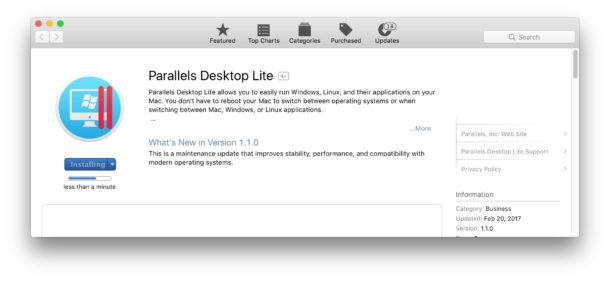
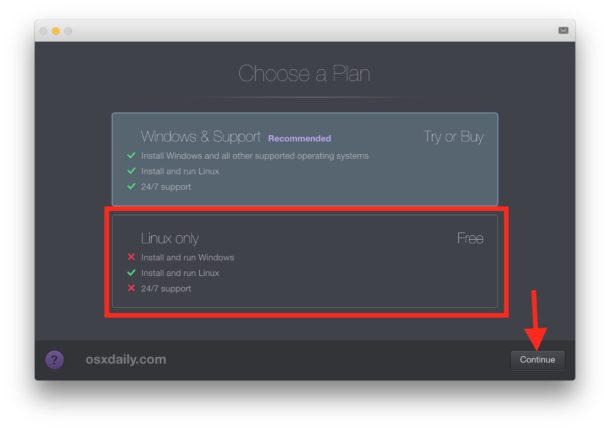
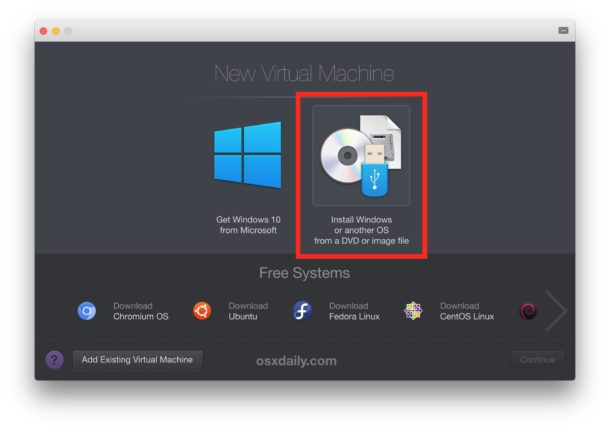
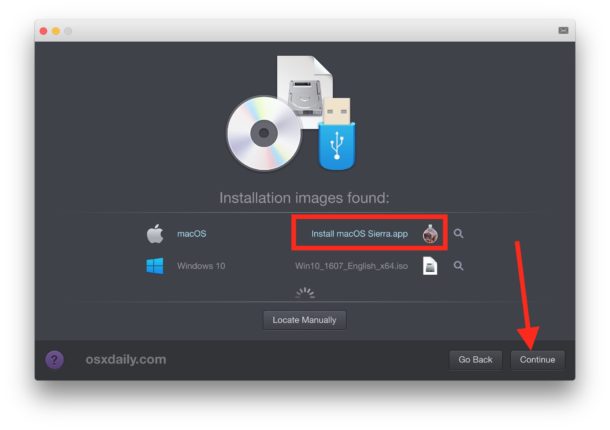
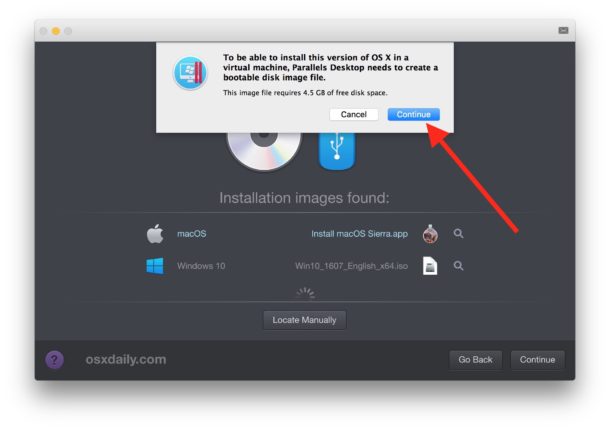
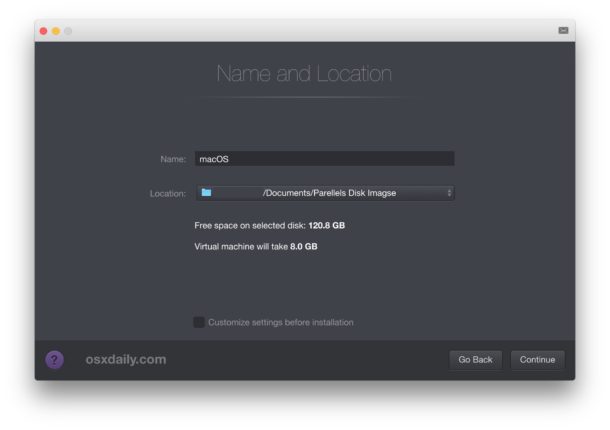
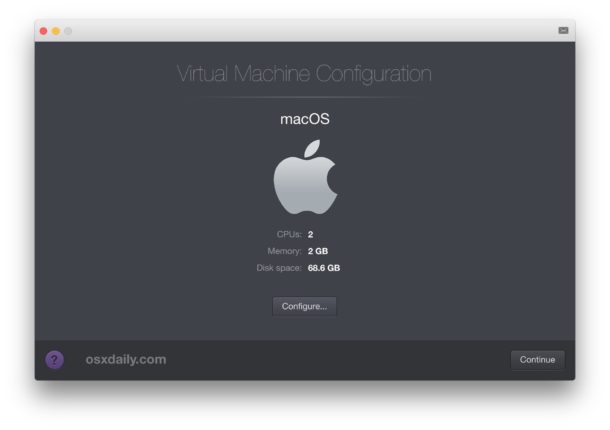
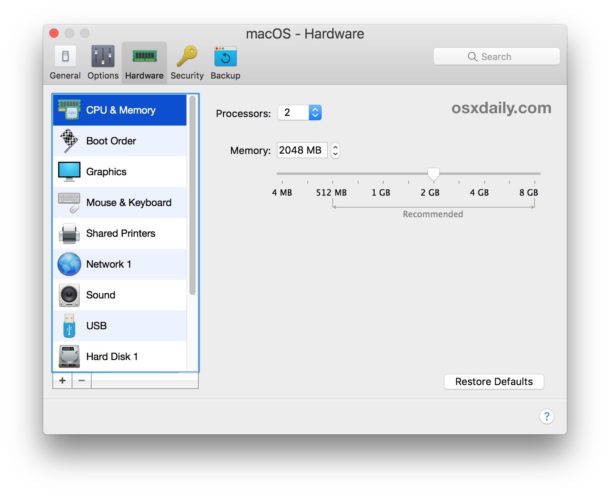
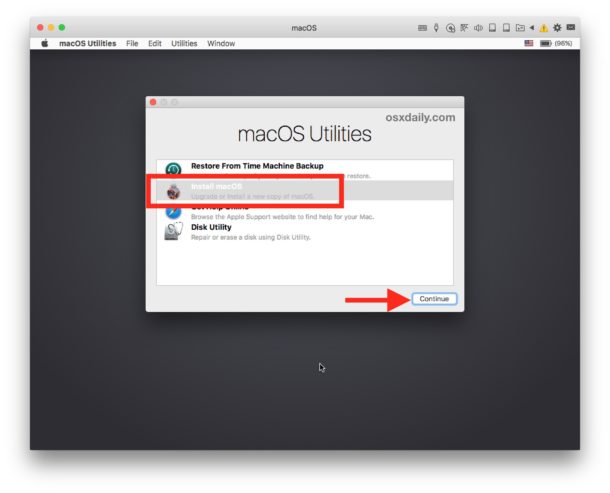
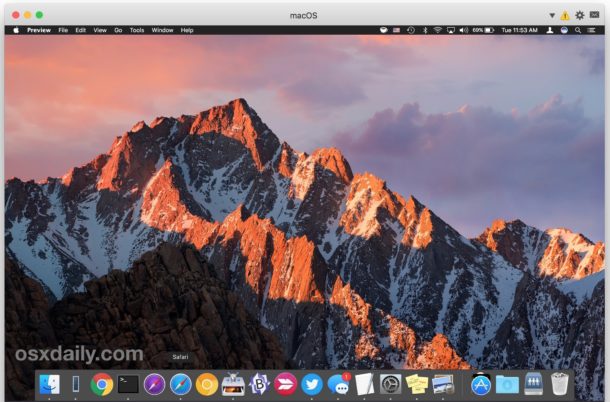
That’s all there is to it, when finished the Mac will be running another version of MacOS in within the Parallels virtual machine. Easy! You can go full screen and use it full time if you want, or keep it in window mode.
In the walkthrough here we installed macOS Sierra into a virtual machine atop Mac OS Sierra, but you could also use it to install other versions of Mac OS including beta releases, El Capitan, Mavericks, and theoretically just about any other Mac system software release that you have available as an installer file, iso file, or other disk image.
You boot and shut down the Mac virtual machine by launching and quitting the Parallels Desktop Lite app, which will manage the virtual machine and offer power options directly.
* Parallels Desktop Lite is free to download and use for the purposes described here, additional features and operating system support can be unlocked through in-app purchases but that is not necessary for running a Mac OS virtual machine. Another option for Windows and Linux is to use VirtualBox, which is free for every purpose.
** You can also choose to restore from a time machine backup in the MacOS setup screen if you want to replicate an existing Mac installation for testing purposes.
While we have covered many virtualization and virtual machine tips and tricks before, this Parallels Lite approach offers a simple way to run Mac OS or Mac OS X within a virtual machine, and it’s free. A big thanks to our friend Keir at MacKungFu for discovering the Parallels Desktop Lite app has this functionality.
Happy virtualizing! Let us know in the comments if you have any particularly useful tips, tricks, or recommendations about running Mac OS in a VM.


Hi there. Im trying to migrate my Mojave system over to VM so i can upgrade to big sur and keep my 32bit apps available when i want them. I’ve installed a new version of mojave into a VM but when i go to migration assistant it can’t see my time machine drive. Anyone got any advice? can i only use time machine during the installation of the macos (i selected to ‘migrate later’ at this point)? anyone got a good in depth video for all this?
Parallels lite no longer appears available and I have a copy of Parallels 16 that I purchased to run windows 10 under Catalina. However, there are many options for versions of Linux and I tried installing Debian, but am lost on how to proceed from there. Can someone suggest what do in 2020?
Looks like they changed Parallels Lite. Now you have to pay to get more than 14 days of anything.
Try VirtualBox, it’s free and works great.
Anyone have a good step by step guide on using Virtualbox to do the same thing as outlined in this article? Run a virtual macOS installation? Parallels Lite is no longer free beyond 14 days, so it’s not a good option for this anymore, well, if you don’t want to pay for it anyway.
As of March 2025, VirtualBox is no longer available for Intel Macs. :-(
Anything else worth using to run Ubuntu? I want to run the Sandstorm suite, and it only runs on fake UNIX.
I need to do this to check an application from a less-than-possibly-trustworthy source. Will the VM of macOS protect my root OS from any nefarious code in the app?
I followed the instructions but it wants to install ONLY on my main partition NOT onto a virtual disk image drive – am I doing something wrong?
The parallels website states that their software will not run on anything older than 2011. I was able to run it on a 2010 MacBook Pro, 2010 Mac Pro – but not a 2009 Mac Pro.
I did try this method to install Windows 7, but at the end Parallels shows it will run free for 14 days :/
Well yes, Windows 7 is not Mac OS. You can run linux or Mac OS free in Parallels Lite. You can run Windows 7 in VirtualBox free for eternity, however.
You can run Windows 10 for ever in VirtualBox too.
Yes, but there are some problems with the network when I’m running Citrix XenCenter on Virtualbox and VSphere Client, Parallels don’t give me any errors. So, I guess I’ll try to purchase it.
Parallells often makes my machine crash.
I have Macbook Pro late 2008 with 8 Gig of RAM on board and this thing says it cannot run on this hardware
I’m not following how I can use wifi in the virtual machine, do you have any instructions for this configuration?
Mine setup automatically with wi-fi. Internet connectivity should pass through and work immediately in the virtual machine, whether wi-fi or ethernet.
Thanks for the reply.
I try loading yahoo via safari and the progress bar stops midway through trying to load the site.
I’ve installed parallels_lite on a macbook pro running sierra and installed sierra on my virtual machine.
I’m at a loss.
Why don’t you just do hackintosh!!! more hackintosh articles please!
I’m wondering how I get Sierra when I’m running El Capitan. App Store says Sierra “can’t be installed on this computer.”
You’ll find all the information you need to install Sierra on unsupported Macs here. Works like a charm.
http://dosdude1.com/sierrapatch.html
In order to use Snow Leopard via virtualization, you must have Snow Leopard Server due to EULA requirements. I believe you can still order a DVD of SL Server from Apple for around $20 if you call and ask nicely. There are lots of tips online (search for it) on how to install SL Server on Parallels. I use it myself.
How much storage space does the Sierra VM take up after it is installed?
You say in the article:
”…but you could also use it to install other versions of Mac OS including beta releases, El Capitan, Mavericks, and theoretically just about any other Mac system software release that you have available as an installer file, iso file, or other disk image…”
How far back could one actually go? For instance, on an old laptop I still have System 9, with Classic. This allows me to open files back to PageMaker 4.5 in Classic and in PageMaker Version 7 and then transfer to open as InDesign files in CS6 and then in CC2017. In my 30 years of book publishing I now find increasing calls for very old books to be made into eBooks and this has been a great benefit. But one day the laptop will fail and if I can use this process it would be wonderful. But this may be a leap Back to the Future too far… I think I recall that nothing that far back will work on modern platforms.
Virtualization is limited to intel CPU I believe so that would be mid-release Mac OS X releases and newer, though it would be great to have a Mac Classic emulator with System 7, 8, and 9!
Check out sheepshaver. This is a virtual machine for Mac classic. It works very well!
Ray S., I’d try copying the files from the DVD to a USB flash drive and use that as the source.
Stewart, the Sierra install is in a separate environment – none of the installed apps are available, unless you install them under Sierra.
Regards,
Francis.
Francis,
Thanks for that info. Pretty much what I thought but glad you verified it. Much appreciated.
— Stewart
I’d like to install Snow Leopard from the DVD into a virtual machine using Parallels Lite but it won’t recognize the install from a DVD. Suggestions?
It sees the DVD but says I can only install OS X Server Snow Leopard (which I don’t have).
You can purchase Snow Leopard Server from Apple:
Mac OS X 10.6 Snow Leopard – Apple Store (U.S.) $19.99 + sales tax & shipping
(call 1.800.MYAPPLE
1.800.692.7753).
Part no: MC588Z/A
When I ordered, the sales rep wasn’t even aware they still offered this product. I ordered in Jan 2017.
See this link: https://forums.macrumors.com/threads/installing-snow-leopard-and-rosetta-into-parallels-7-in-lion.1365439/page-30#post-20685009
I was able to install Sierra and El Capitan in this easily, but Snow Leopard EULA doesn’t allow virtualization if I remember correctly, though SL does install in VirtualBox… VirtualBox is also free you could try that, it’s from Oracle.
This is fascinating, especially for someone who has never messed around with VM before. I have been wanting to upgrade to Sierra from El Capitan but Intuit says my Quickbooks Pro 2014 for Mac won’t run on Sierra. Most other applications of importance will. But since QB is critical to me, and I don’t want to shell out another $200+ to Intuit for the privilege of continuing to run 2-yr-old software, I haven’t upgraded.
So, my question is, just so I’m clear: if I do this install of the VM on El Capitan, and then install Sierra (as you’ve done in your example), can I make Sierra my PRIMARY OS (operating from within the VM) and just switch back to El Capitan when needed to use QuickBooks and any other apps that won’t play nice with Sierra? And when further upgrades come, continue to do those within the VM?
Hope that’s clear. Sounds as if this is possible, but would just like to clarify and know that’s correct before I start messing around. Thanks. I look forward to your response.
It might be better to upgrade your real machine to Sierra, and then install El Capitan in your VM. That way, everything except your back level QB will run in your primary machine.
Bobber,
Great suggestion. To be clear, would I then need to re-install those apps (such as QuickBooks) that I’d want to run via El Capitan on the VM? Is there any way in the installation process to essentially point the VM to the already existing El Cap set up? Thanks again for your suggestion, as I hadn’t really thought about that option. But it does raise new questions. Any thoughts would be welcome. Thanks again!
You could make a time machine backup of your current El Capitan system to an external drive, then update your system or do a clean install of Sierra. Once that is done complete this VM project using El Capitan and during the installation select migrate from a time machine backup so you get all your stuff back including QB and your settings in your new VM environment. If you don’t want all of that stuff in your VM environment then just backup your QB data from your current system to somewhere safe, install QB in your newly installed El Capitan VM environment and load from you backed up QB file.
You could certainly install Sierra into a VM with this method and use it, experiment with it, but because Mac OS is running on virtualized hardware you will find performance is limited and less than you’d experience in a true native booting environment. I tend to feel that virtual machines are at best 1/2 of the speed of running natively on a computer, maybe even closer to 1/4 the performance or sometimes even less. Virtualization and VM’s are helpful for testing, but I wouldn’t want to run everything within one full time for heavy duty needs.
My personal recommendation is stay with the Mac OS version that is compatible with the apps you need, if QB is critical and only compatible with El Cap than I would stay put. I run El Cap on one of my Macs and Sierra on another.
Paul,
Thanks for this info relating to the performance factor. Figured there would be some hit but not this much. Yikes! Your option of running El Cap on one Mac and Sierra on another is a great…if I could only afford the new Mac! LOL
Again, appreciate the insights and recommendation.
This is nice, I didn’t know about Parallels Desktop Lite.
You can also run MacOS in Vmware and VirtualBox, with Virtual Box you have to use an ISO or boot drive to boot though. And all of them run Windows. You can also run Windows natively with Boot Camp for best performance.
Tried the app out a few weeks ago but found it wouldn’t let me install macOS Sierra but I didn’t know until now that you had to use the “Linux Only” option.